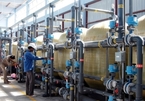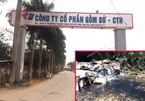
Residents in Linh Đàm urban area of Hoàng Mai District, Hà Nội,on late October 15 brought canisters and buckets to fetch water from a water tanker truckafter their main supply from the Đà River became contaminated with waste oil.
The Đà River Water Investment JSC, Co (VIWASUPCO) – which runs the Đà River water plant – said in a press release that it wanted to convey its apologies via the media to residents, especially those directly affected by the crisis, and begged for their forgiveness.
“As an enterprise, we are aware of the unease and confusion we have caused residents, which is the biggest loss for us,” said the press release.
“We provided tap water for free during the incident, which is equal to a month of free water.”
The company also said that it had completed all necessary procedures to be able to resume supplying clean tap water to residents.
Regarding the quality of the water, the National Institute of Occupational and Environmental Health took samples from the Đà River plant for testing on October 14, 16 and 18 while the Quality Assurance and Testing Centre (QUATEST) and the Hà Nội Centre for Disease Control also carried out internal quality tests on October 16, according to the press release.
Based on the test results, the company said the tap water met all the quality criteria issued by the Ministry of Health. The water was now deemed safe for consumption and other living activities, the company said.
Tap water was turned back on the night of October 16.
No response plan
VIWASUPCO finally broke its silence with the press release since its deputy director appeared at a press conference on October 17. He there refused, twice, to send an apology to affected residents, saying “everyone should wait till the authorities reach a conclusion (on the investigation).”
The worst water crisis Hà Nội has seen in decades began early this month when several households using tap water supplied by the Đà River water plant reported a strangely irritating smell like melted plastic or oil in the water.
Tests conducted by authorities came back with bad news. Styrene, an organic compound often used to produce plastic and might cause cancer after long exposure, was found in the water at levels between 1.3 and 3.65 times higher than those permitted.
In response, the city immediately issued a warning telling people living across eight districts to refrain from using tap water. It was estimated that at least 700,000 people in the southwest of Hà Nội were affected by the unprecedented crisis.
Authorities also discovered that 10cu.m of waste oil had been illegally dumped near the plant and had made its way into the sole reservoir and polluted the whole plant.
VIWASUPCO continued pumping the toxic water to the city despite being well aware of the pollution.
Police have already arrested three people who allegedly disposed of the waste oil.
According to the press release, the company had to send its own staff as well as hire more workers and the SOS Environment company to clean up the pollution. They collected scum oil using absorbing buoys and poured charcoal into a 3km channel running into the reservoir, as well as dredging the whole area.
VIWASUPCO also flushed its pipe network and water tanks at the plant as well as at the affected households.
The company said that it had “failed to have an appropriate response plan in place for a human-made emergency” at the time of the incident, which “resulted in confusion in first response, and interrupted the lives of people in the southwestern part of Hà Nội”.
It committed to build response plans for all types of emergencies and to recruit and train staff in order to ensure a stable supply of standard quality water to residents. — VNS

Investors should take a look at divestment in Vietnam's water sector
Recent reports of contaminated tap water have caused great public concern across Viet Nam, the latest issue for investors in a sector the State is divesting from.

Company identified as source of waste oil in Hanoi water pollution case
A ceramic company in Phu Tho Province has admitted that the waste oil in the recent water contamination incident originated from them but said they had never signed off the decision to dispose of or release the oil.
 The water plant at the centre of a pollution crisis in Hanoi on Friday made an official apology to thousands of customers, promising them a month's supply for free.
The water plant at the centre of a pollution crisis in Hanoi on Friday made an official apology to thousands of customers, promising them a month's supply for free.